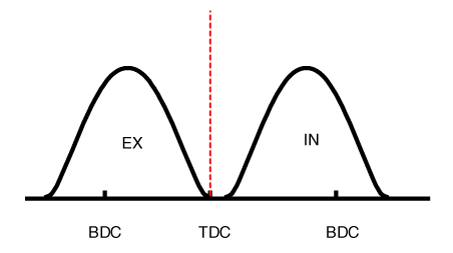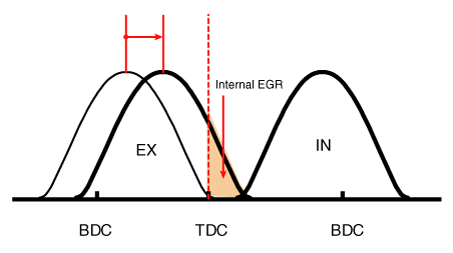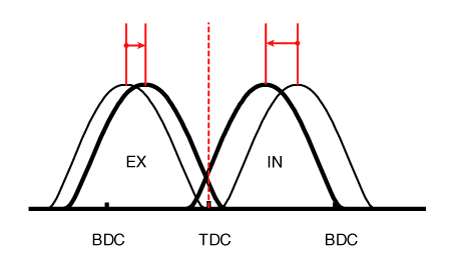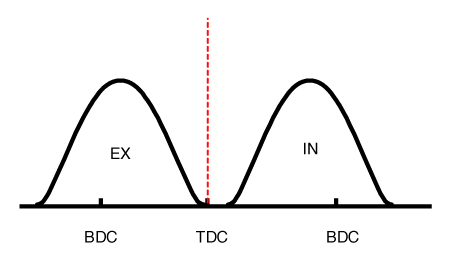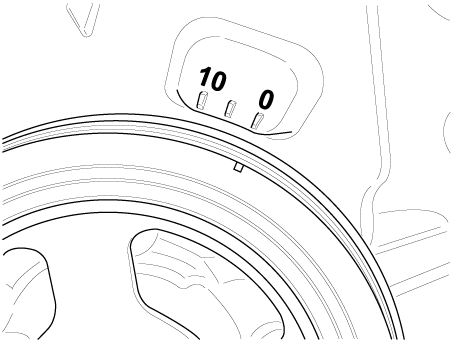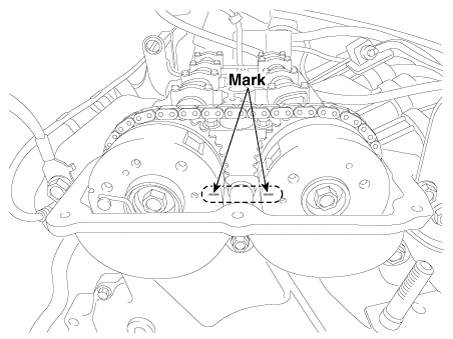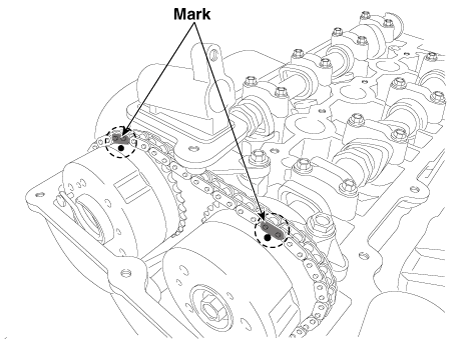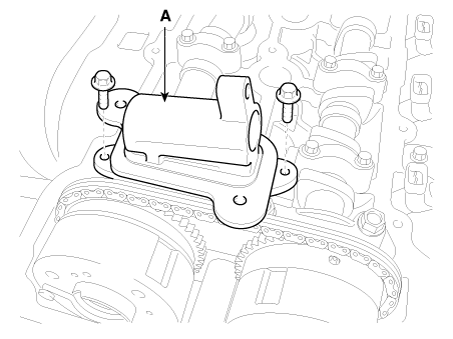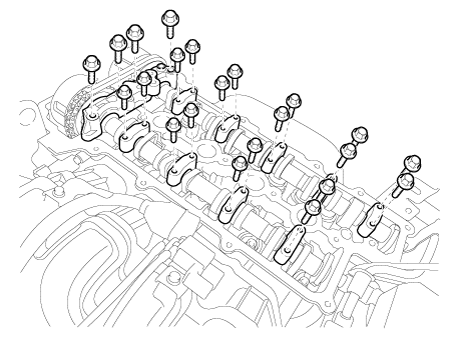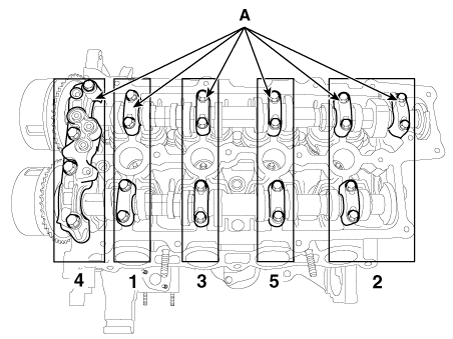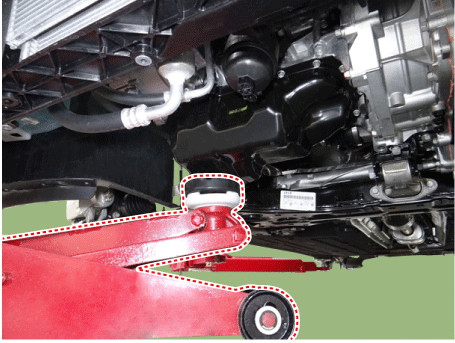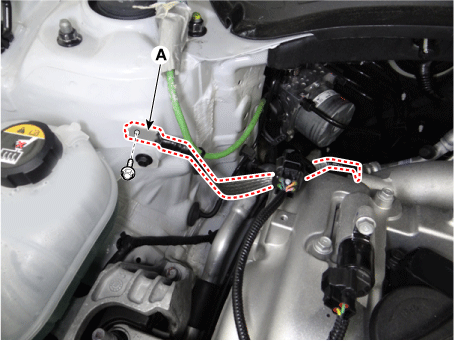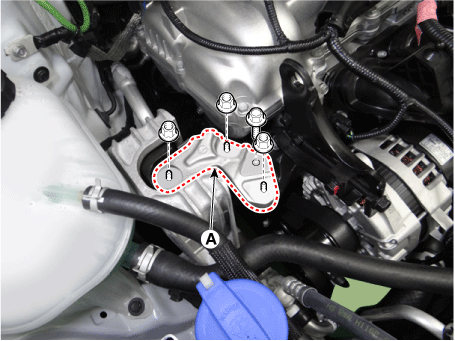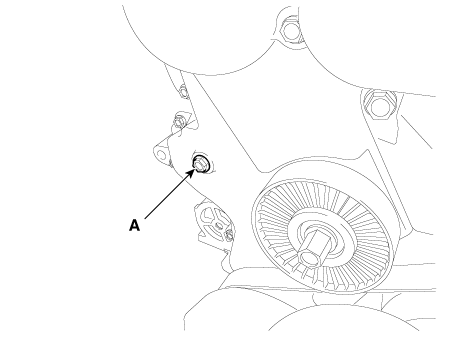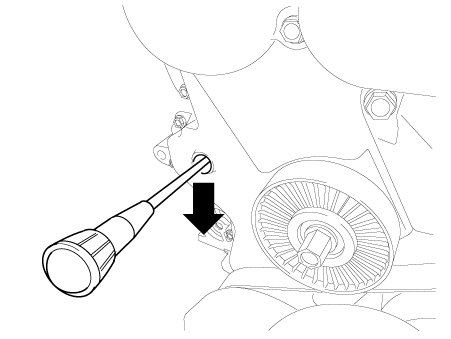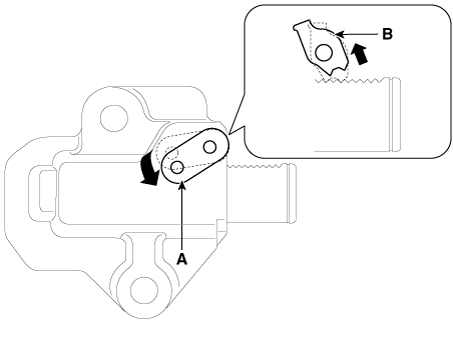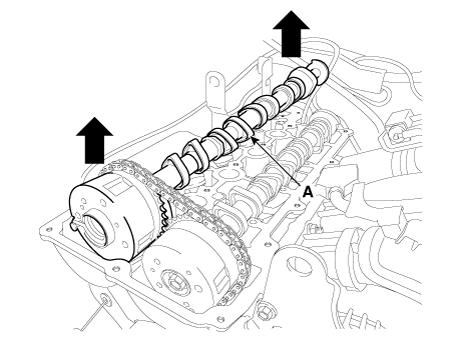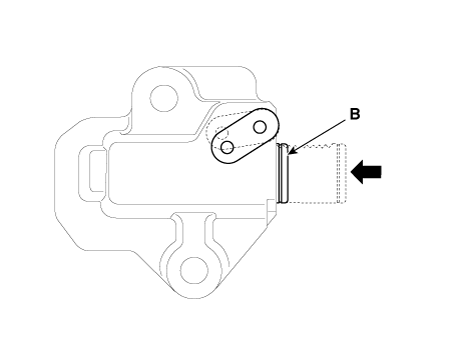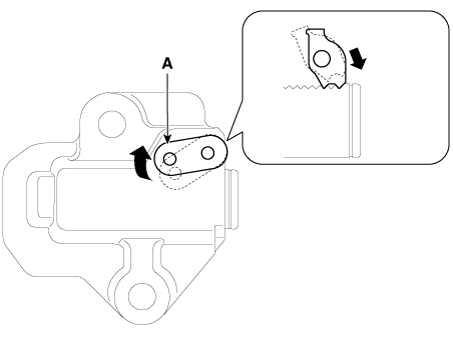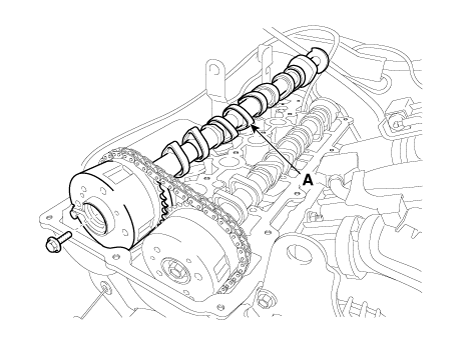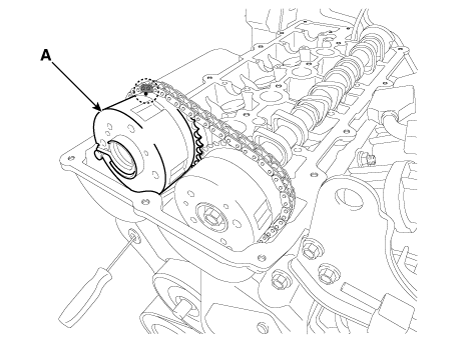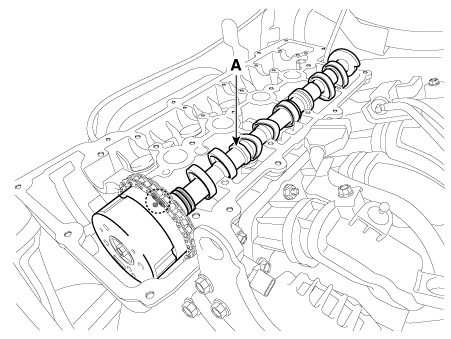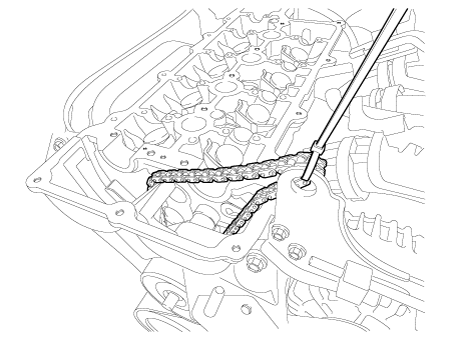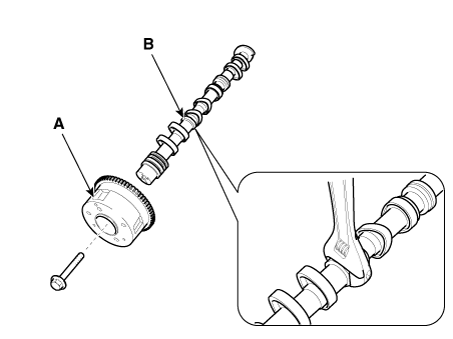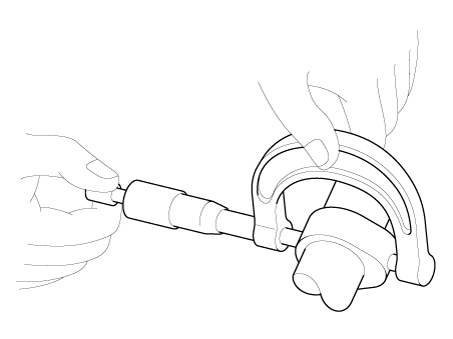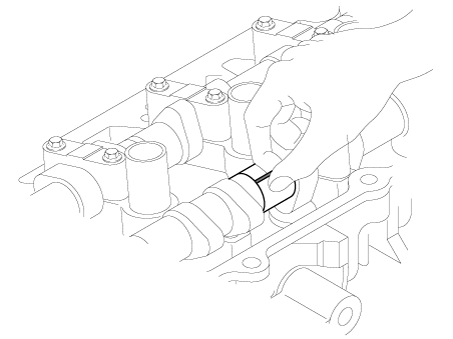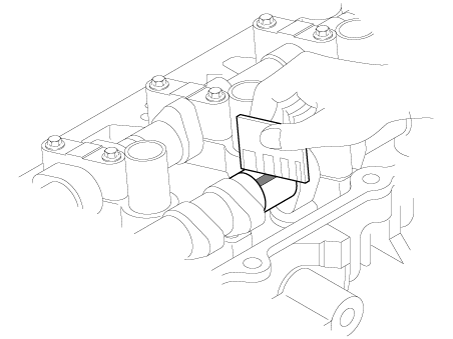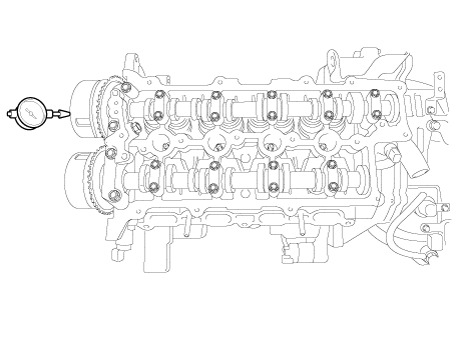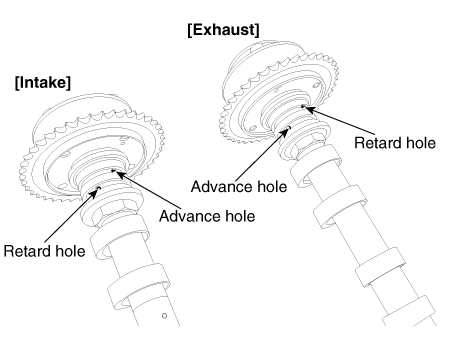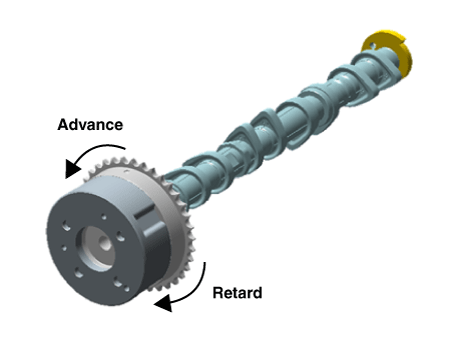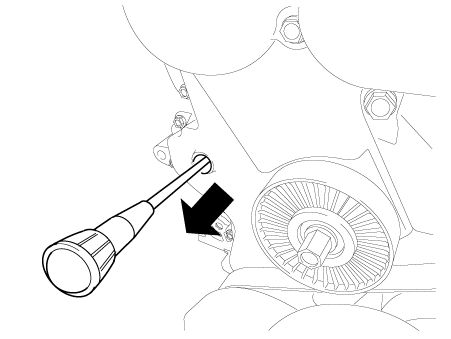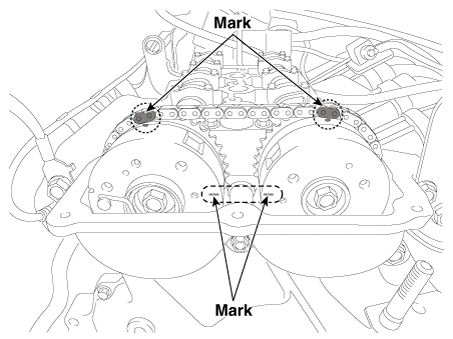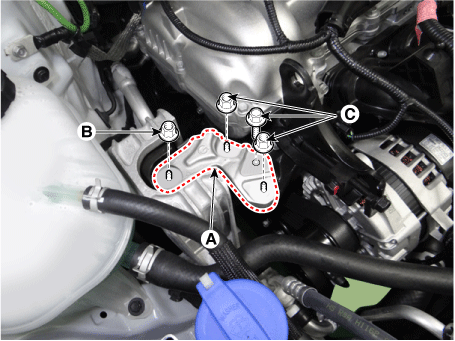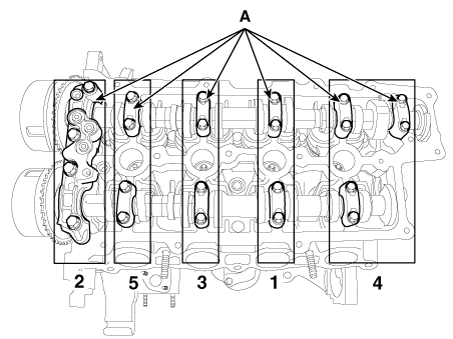Kia Forte: Cylinder Head Assembly / CVVT & Camshaft
Components and components location
| Components |
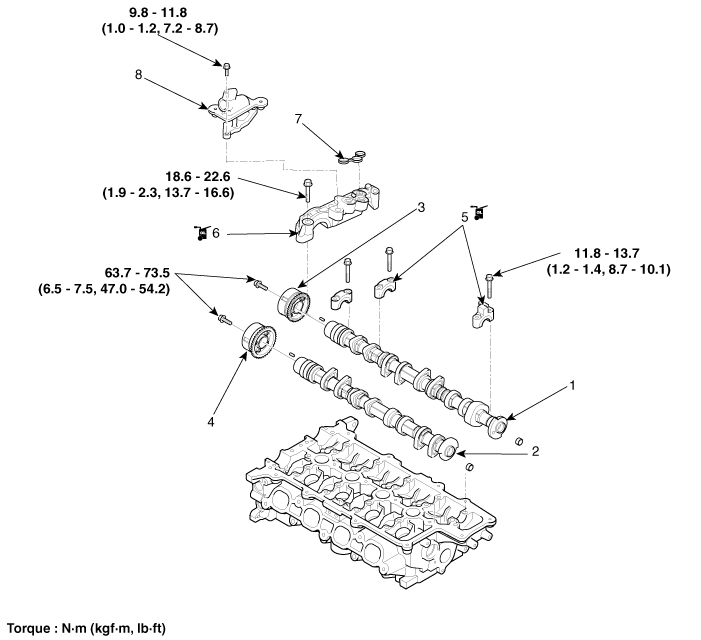
| 1. Exhaust camshaft 2. Intake camshaft 3. Exhaust CVVT 4. Intake CVVT |
5. Camshaft bearing cap 6. Camshaft front bearing cap 7. O-ring 8. Oil control valve (OCV) adapter |
Description and operation
| Description |
Continuous Variable Valve Timing (CVVT) system advances or retards the valve timing of the intake and exhaust valve in accordance with the ECM control signal which is calculated by the engine speed and load.
By controlling CVVT, the valve over-lap or under-lap occurs, which makes better fuel economy and reduces exhaust gases (NOx, HC) and improves engine performance through reduction of pumping loss, internal EGR effect, improvement of combustion stability, improvement of volumetric efficiency, and increase of expansion work.
This system consist of
| – |
the CVVT Oil Control Valve (OCV) which supplies the engine oil to the cam phaser or runs out the engine oil from the cam phaser in accordance with the ECM PWM (Pulse With Modulation) control signal, |
| – |
the CVVT Oil Temperature Sensor (OTS) which measures the engine oil temperature, |
| – |
and the Cam Phaser which varies the cam phase by using the hydraulic force of the engine oil. |
The engine oil getting out of the CVVT oil control valve varies the cam phase in the direction (Intake Advance/Exhaust Retard) or opposite direction (Intake Retard/Exhaust Advance) of the engine rotation by rotating the rotor connected with the camshaft inside the cam phaser.
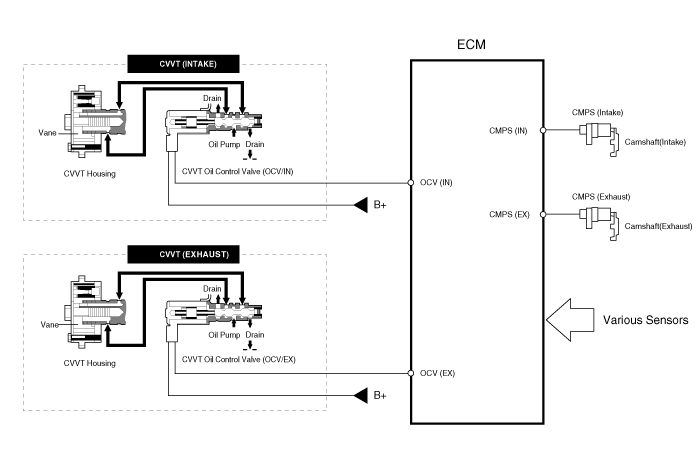
| Operation Principle |
The CVVT has the mechanism rotating the rotor vane with hydraulic force generated by the engine oil supplied to the advance or retard chamber in accordance with the CVVT oil control valve control.
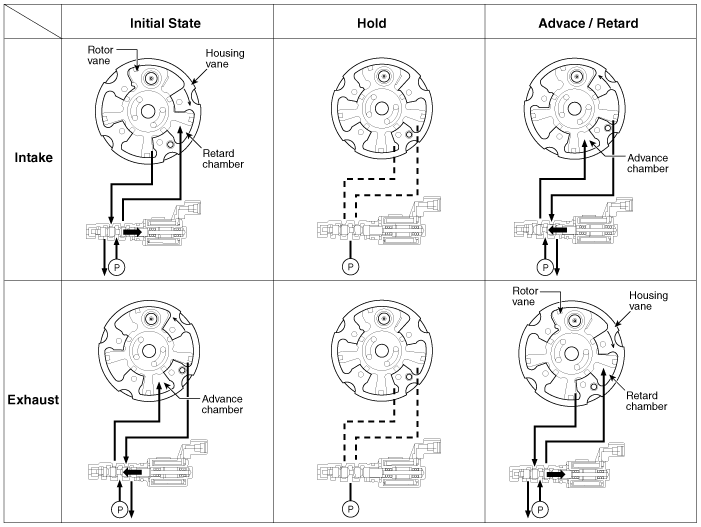
| [CVVT System Mode] |
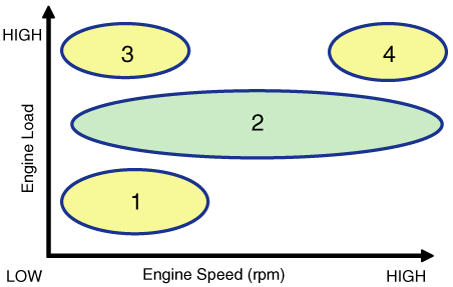
|
(1) Low Speed / Low Load |
(2) Part Load |
|
|
|
|
(3) Low Speed / High Load |
(4) High Speed / High Load |
|
|
|
|
Driving Condition |
Exhaust Valve |
Intake Valve |
||
|
Valve Timing |
Effect |
Valve Timing |
Effect |
|
|
(1) Low Speed /Low Load |
Completely Advance |
* Valve Under-lap * Improvement of combustion stability |
Completely Retard |
* Valve Under-lap * Improvement of combustion stability |
|
(2) Part Load |
Retard |
* Increase of expansion work * Reduction of pumping loss * Reduction of HC |
Retard |
* Reduction of pumping loss |
|
(3) Low Speed /High Load |
Retard |
* Increase of expansion work |
Advance |
* Prevention of intake back flow (Improvement of volumetric efficiency)
|
|
(4) High Speed /High Load |
Advance |
* Reduction of pumping loss |
Retard |
* Improvement of volumetric efficiency |
Repair procedures
| Removal |
| 1. |
Remove the cylinder head cover. (Refer to Cylinder Head Assembly - "Cylinder Head Cover") |
| 2. |
Turn the crankshaft damper pulley so that No. 1 piston is at top dead center.
|
| 3. |
Remove the exhaust oil control valve (OCV) adaptor (A).
|
| 4. |
Remove the camshaft bearing caps (A) in the order of image below.
|
| 5. |
Remove the engine mounting support bracket.
|
| 6. |
Remove the bolt (A) from the service hole in the timing chain cover.
|
| 7. |
Lock the timing chain tensioner in the fully retracted position.
|
| 8. |
Separate the exhaust camshaft (A) from the exhaust CVVT by removing the bolt.
|
| 9. |
Remove the exhaust CVVT (A) from the timing chain.
|
| 10. |
Remove the intake CVVT & camshaft (A).
|
| 11. |
Remove the intake CVVT (A) from the intake camshaft (B).
|
| Inspection |
Camshaft
| 1. |
Measure the height of the cam lobe using a micrometer and check the surface of the cam lob for wear and tear. If necessary, replace the camshaft.
|
| 2. |
Check the surface of the camshaft journal for wear and tear. If the camshaft journal is excessively damaged, replace the camshaft. |
| 3. |
Inspect the camshaft journal clearance.
|
| 4. |
Inspect the camshaft end play.
|
CVVT (Continuously Variable Valve Timing) Assembly
| 1. |
Inspect the CVVT for smooth rotation.
|
| Installation |
| 1. |
Install the intake CVVT (A) to the intake camshaft.
|
| 2. |
Install the intake CVVT & camshaft (A), with the timing mark on the intake CVVT sprocket aligned with the mark (painted link) on the timing chain.
|
| 3. |
Install the exhaust CVVT (A), with the timing mark on the exhaust CVVT sprocket aligned with the mark (painted link) on the timing chain.
|
| 4. |
Install the exhaust camshaft (A) to the exhaust CVVT.
|
| 5. |
Remove the pick from the service hole in the timing chain cover.
|
| 6. |
Check that each timing mark of the intake and exhaust CVVT sprockets is aligned as shown in the picture.
|
| 7. |
Tighten the bolt (A) to the service hole in the timing chain cover.
|
| 8. |
Install the engine mounting support bracket.
|
| 9. |
Install the camshaft bearing caps (A) in the order shown in the picture and tighten the bolts to the specified torque.
|
| 10. |
Install the exhaust oil control valve (OCV) adaptor (A).
|
| 11. |
Install the cylinder head cover. (Refer to Cylinder Head Assembly - "Cylinder Head Cover") |
 Cylinder Head Cover
Cylinder Head Cover
Components and components location
Components
1. Cylinder head cover
2. Cylinder head cover gasket
3. Oil cap
4. Cup packing
Repair procedures
...
 Cylinder Head
Cylinder Head
Components and components location
Components
1. Cylinder head assembly
2. Mechanical lash adjuster (MLA)
3. Retainer lock
4. Retainer
5. Valve stem seal
...
Other information:
Kia Forte 2019-2025 (BD) Owners Manual: Windows
(1) Driver’s door power window switch (2) Front passenger’s door power window switch (3) Rear door (left) power window switch (4) Rear door (right) power window switch (5) Window opening and closing (6) Automatic power window up*/ down* (7) Power window lock button ✽ N ...
Kia Forte 2019-2025 (BD) Service Manual: Tire Pressure Monitoring System
Components and components location Components 1. ESC control module 2. Cluster 3. TPMS SET Switch 4. Wheel speed sensor 5. Tone wheel Description and operation Description Indirect Tire Pressure Monitoring System (TPMS) Using ...

